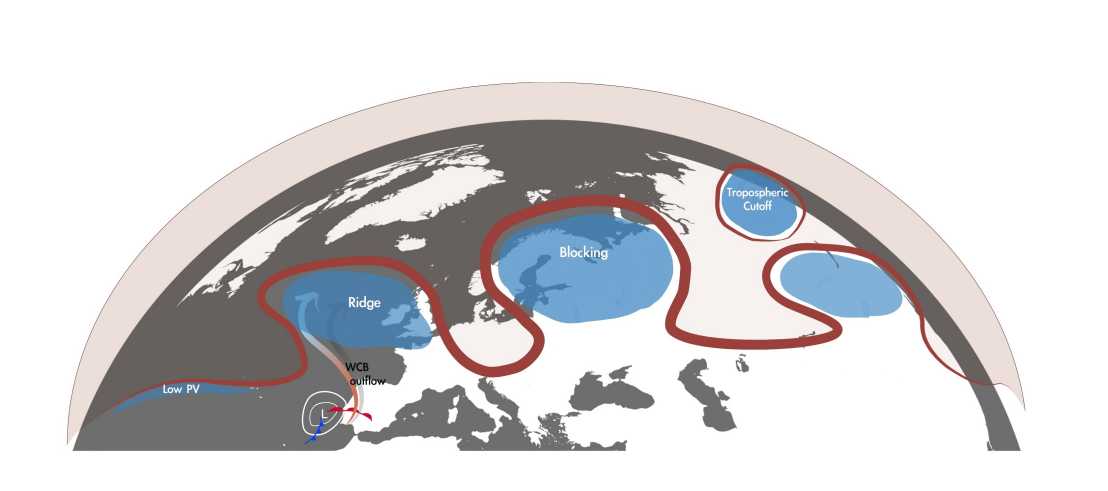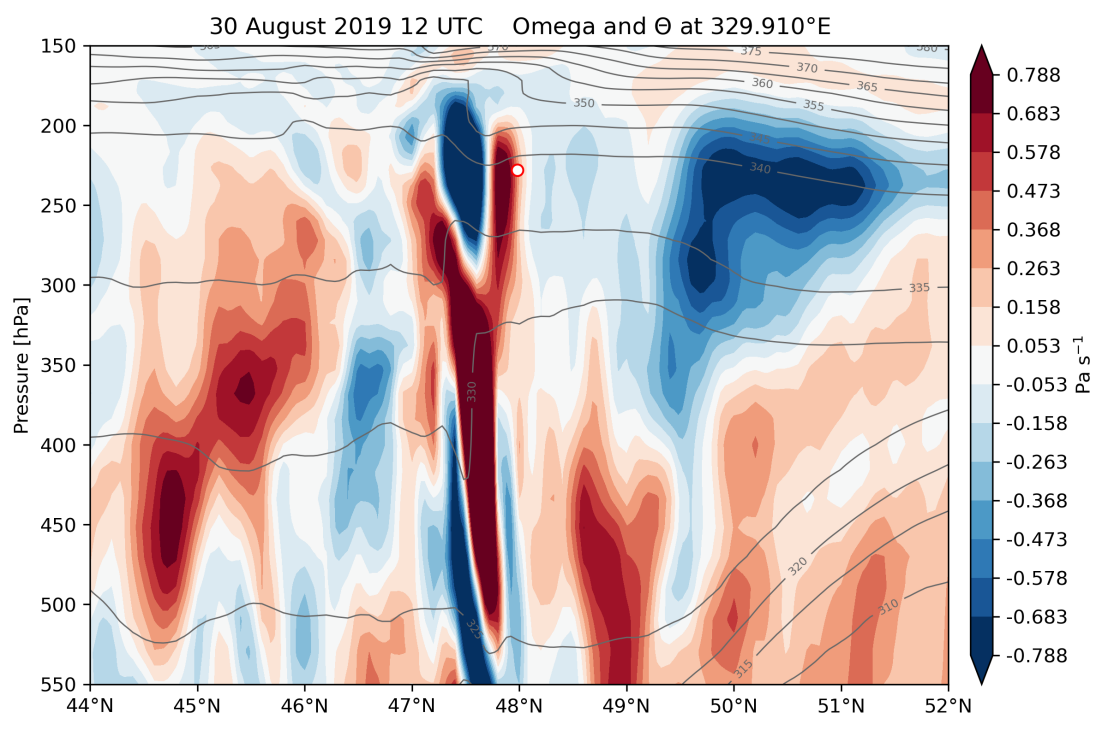Tropopause dynamics
The tropopause is the boundary between the troposphere and the stratosphere. In dynamical meteorology it is typically defined as an iso-surface of potential vorticity (PV) because the tropospheric low-PV values clearly differ from the large stratospheric PV values. However, dynamically more important is PV's conservation under adiabatic/frictionless flow and the invertibility principle, which states that distinct PV anomalies are associated with corresponding wind and temperature anomalies. The such defined dynamical tropopause (2-PVU iso-surface) exhibits many key atmospheric features, which become particularly evident if PV is considered on isentropic iso-surfaces. In particular, a waveguide for Rossby waves can be attributed to a band of enhanced PV gradients. Rossby waves can propagate along these waveguides, and potentially strongly amplify before leading to Rossby Wave Breaking (RWB) events. On the isentropic PV charts, these RWB events are discernible as narrow, elongated filaments of high-PV air extending equatorward or low-PV air extending poleward (so-called PV streamers). Besides these horizontal distortions of the PV field on the isentropic surfaces, the dynamical tropopause exhibits many vertical distortions (tropopause intrusions and folds, upper-level fronts), e.g. associated to intrusions of stratospheric air extending to mid-tropospheric levels and potentially leading to mass and tracer exchange between the two spheres (stratosphere-troposphere exchange; STE). In summary, the dynamical tropopause is a highly complex meteorological feature that affects both the dynamics and chemistry at the upper and lower levels.
Studying the dynamics of the tropopause has a long tradition in our research group. Particular focus is given to the identification of PV-based mesoscale- and synoptic-scale features (PV cutoffs, PV streamers, tropopause folds), but also how they relate, e.g., to jet streams and jet streaks. Recent studies also looked at the radiative and turbulent processes affecting the tropopause structure and evolution by applying a sophisticated Lagrangian PV budget analysis and by studying in detail how, e.g., cirrus clouds affect near-tropopause heating and PV rates. Additionally, the impact of the tropopause on the evolution of tropospheric flow features (cyclones, anticyclones, blocks) are investigated. Additionally, Lagrangian STE climatologies have been compiled. A key topic of the research in our group is dedicated to the processes that can disturb the tropopause, potentially leading to initially localized distortions of the tropopause or a PV-based waveguide that then propagate downstream and thus even affect weather and its predictability far downstream of the interaction point. For instance, Warm Conveyor Belts (WCB), ascending air streams within cyclones' warm sector and finally reaching upper-tropospheric levels, are studied in great detail, in particular how they trigger and/or influence near-tropopause cirrus clouds, their radiative heating gradients and their associated PV modifications. The interaction of WCBs with the jet, or the PV-waveguide, and the subsequent evolution of the upper-tropospheric flow is a key research topic of the group. In particular. we are interested how this interaction triggers or contributes, downstream, to distinct weather features (e.g., PV streamers, blocks, PV cutoffs). Finally, the weather features are also known to lead to Clear Air Turbulence (CAT) at commercial flight levels, thus severely affecting aircraft efficiency and safety. Processes and weather features leading to CAT are studied in detail.
The afore-mentioned research goals are achieved by making use of comprehensive observational and (re-)analysis/forecast datasets provided by ECMWF, but also by performing dedicated (high-resolution) NWP simulations.
The senior scientists working in this research area and their core themes are Michael Sprenger (STE, CAT) and Lukas Papritz (atmospheric blocks) and Hanna Joss (WCB).
The PhD projects conducted in this reasearch area are outlined below:
Influence of Warm Conveyor Belts on Rossby Wave Dynamics

Vishnu Selvakumar
Atmospheric Rossby waves and associated potential vorticity (PV) disturbances significantly modulate midlatitude weather and climate variability. Former studies have identified warm conveyor belts (WCBs) as one of the dominant synoptic-scale systems that can modify the upper-level flow and the Rossby waveguide. WCBs are rapidly ascending airstreams associated with midlatitude cyclones that transport air from the surface boundary layer to the upper troposphere. The outflow of the WCBs is characterized by strong divergent flow and intense upper-level negative PV anomalies that can impact the Rosbby waveguide and the downstream flow evolution.
This PhD project aims to investigate the puzzling variability concerning the interaction between WCBs and the Rossby waveguide, which is directly relevant for medium-range weather forecasting. These interactions can be classified into four levels: (I) weak/no interaction, (II) amplification of an atmospheric ridge, which, under favorable conditions, can further lead to the formation of (IIIa) a block, or (IIIb) a tropospheric cutoff. The main aim is to objectively identify the interaction categories in the ERA5 reanalysis data and to understand the factors (strength of WCBs, jet stream, and waveguide measured as ambient PV gradient) influencing these interactions. These findings will help to understand the seasonal frequency and geographical distribution of the different interaction levels and the possible mechanisms explaining the distribution. Additionally, these analyses will also be conducted using ensemble forecast simulations to understand the predictability and forecast uncertainty of different interaction levels.
Supervised by Michael Sprenger, Hanna Joos and Heini Wernli
Processes, impact and predictability of clear air turbulence

Clear Air Turbulence (CAT) is a type of aviation turbulence occurring in the free atmosphere outside of convective activities and it is a concern for aviation safety. Previous studies have shown that CAT is often found in the upper-troposphere lower-stratosphere (UTLS) region near jet streams, upper-level fronts, tropopause folds, etc., where strong wind shear and deformation are present. CAT is also found to be related to cross tropopause exchange in case studies and hence influencing atmospheric composition. However, due to the intermittent nature of CAT and limited observational data, the understanding of CAT in relation to weather conditions favouring its occurrence and the impact of CAT on its surrounding environment is far from complete.
With the introduction of the automated eddy dissipation rate (EDR) measurement on commercial aircraft, which indicates the intensity of turbulence, the number of observations for CAT increases significantly. This new dataset enables us to examine the meteorological situations associated with the observed CAT events and categorize the events accordingly. With the experience in studying various weather systems (e.g. Rossby wave breaking, tropopause folds, warm conveyor belt) and their dynamics near the tropopause, the relationship between CAT and these systems will be analysed for the different subsets of events and extend beyond individual case studies. Besides the large-scale conditions, the impact of CAT on the mesoscale environment will also be explored in several aspects, including its effect on potential vorticity (PV) modification and stratosphere troposphere exchange (STE), with model simulations (IFS, ICON). The Lagrangian PV budget analysis developed will be applied to gain new insight into the impact of CAT. The uncertainty of CAT in current numerical weather prediction is another subject to be studied and we hope to identify sources of error in CAT forecasting.
Supervised by Michael Sprenger, Heini Wernli
